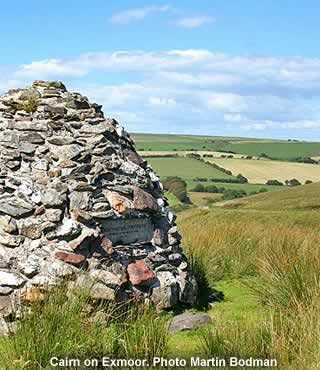Exmoor |
|
 |
|||
Almost entirely open heath and moor land, which is normally covered in grass or heather |
Listen to this article |
Exmoor National Park takes up almost 700 square kilometres of land in Somerset, and part of Devon. It is almost entirely open heath and moor land, which is normally covered in grass or heather. Such vast, wide open spaces are unusual in England, and it makes for some of the most spectacular, panoramic views in any of Britain's National Parks. |
But while you're taking your photographs, don't be surprised if something wanders in front of the camera. Exmoor's sweeping landscape provides a perfect habitat for grazing animals, which are often allowed to wander freely throughout the park. You're most likely to encounter sheep - which have grazed here for over 3000 years - or Exmoor's own race of ponies, which is the oldest type in Britain. You'll also be given ample chances to see red deer, or one of the many birds of prey, including the Peregrine Falcon. |
The attractiveness of both the wildlife and the landscape means that walking is one of the best ways to explore. Exmoor has over 1000km of footpaths and bridleways, giving great access to all the area's nooks and crannies. In some places, you can even leave the paths altogether, and walk through the moor land itself. Some people, on the other hand, may prefer to travel while sitting on a horse or a bicycle. Both are popular, and both are easily available for rent from various shops and stations. |
While you're out there though, you may want to keep your eyes peeled for another creature that may be lurking nearby. This is the haunt of the infamous "Beast of Exmoor", a legendary creature that is said to stalk the moors, hunting sheep, deer, and anything else it can find. There have been sightings since the 60s, with many theorising that it might be a leopard, or a cougar. |
Several other natural features break up the moorland, including the towering cliffs on the park's northern coast, which are the tallest in England. This shoreline also makes up part of the well-known South West Coast Path, the longest national trail in England and Wales. |
Elsewhere, the River Exe runs north to south, lending the area its name, as well as providing a great place for canoeing and fishing. Other water-based activities are available on Wimbleball Lake, including sailing, and windsurfing. Those interested in more active pursuits may also want to investigate the various horse racing and steeplechase events held through the year, at many different venues throughout Exmoor. |
After a hard day's walking, riding, or boating, it will probably be time for a relaxing sit down at one of the many local pubs, scattered throughout the National Park's small towns and villages. These settlements range from the market town of Dunster, with its overlooking hilltop castle, to tiny, beautiful places like Selworthy, with its thatched roof cottages. People looking to make their base in a slightly larger town should head for Minehead, just outside the park's boundaries, which has a wide selection of places to stay - as well as a popular beach. |
Exmoor National Park is one of Britain's most unique landscapes, and with so much to keep you occupied, you're sure to keep coming back. |
|
Pocket Britain is optimised for use on a smartphone or tablet with internet access. All content is subject to copyright. All reasonable methods have been used to ensure information supplied is accurate at the time of publication. However, it is advisable to check information before relying on it. Privacy Policy |